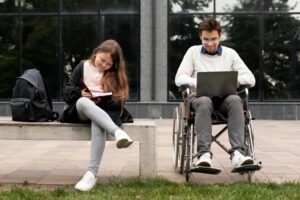Measuring and identifying challenges
Materials
1. Introduction
The importance of inclusive teaching with digital technologies cannot be overstated. By harnessing technology, educators can create a more accessible and engaging learning environment that benefits all students, regardless of their individual needs or circumstances. This approach is essential for promoting equity in education and ensuring that every student has the opportunity to succeed.
The digital divide presents significant barriers for students, impacting their academic performance, social development, and future opportunities. Addressing this divide is crucial for fostering equality in education and equipping all students with the necessary tools for success. Reducing the digital divide requires a comprehensive strategy, including providing access to devices and internet connectivity, offering digital literacy training, establishing equitable school policies, and forming partnerships with both private and public entities. These measures ensure that all students can fully participate in their education, regardless of their socio-economic background or geographic location.
2. Significance of inclusive teaching with digital technologies
Inclusive teaching with digital technologies is a key approach in modern education that ensures every student has equal access to learning opportunities regardless of their background. Digital tools can enhance accessibility, personalize learning experiences, and provide opportunities for distance learning, which is especially important for students with special needs (Gottschalk & Weise, 2023). The integration of digital tools into the classroom enables teachers to cater to a diverse range of student needs, fostering an environment that promotes equity and inclusivity.
The significance of inclusive teaching lies in its potential to break down barriers that traditionally excluded certain groups of students. In the past, students with physical, cognitive, or learning disabilities might have faced difficulties in accessing traditional educational materials or participating in classroom activities. Digital technologies allow educators to create customizable learning environments, using tools like screen readers, speech-to-text programs, and interactive multimedia to accommodate a variety of learning preferences and abilities.
Furthermore, inclusive teaching with digital tools promotes engagement by creating dynamic and interactive learning experiences. Students today are growing up in a digital world, and they are often more motivated to learn when lessons are delivered through platforms that mirror their everyday interactions with technology. Tools like educational apps, videos, and online quizzes can be used to make learning more engaging and enjoyable, especially for students who may struggle with traditional methods.
Another important aspect of inclusive teaching with digital technologies is its ability to promote collaboration. Students can work together on digital platforms, sharing ideas and solving problems collectively. This collaborative approach not only supports learning but also helps students develop essential life skills like teamwork and communication.
3. The negative impact of the digital divide on students
The digital divide refers to the gap between individuals who have access to digital technologies and those who do not. This divide can have a significant negative impact on students, particularly in the context of education, where access to technology is increasingly necessary for success. The digital divide affects students in various ways, creating disparities that can have long-term consequences for their academic achievement and future opportunities. (Bowyer et al., 2021; Gottschalk & Weise, 2023; Sparks, 2019)
One of the most obvious impacts of the digital divide is the unequal access to educational resources. In today’s learning environment, many schools rely heavily on digital tools such as online textbooks, educational platforms, and virtual classrooms. Students without access to computers or reliable internet at home are disadvantaged, as they may struggle to complete assignments, access important information, or participate in virtual lessons. This lack of access can lead to lower academic performance and increased frustration, as students without digital tools are unable to keep up with their peers. (Bowyer et al., 2021; Gottschalk & Weise, 2023; Sparks, 2019)
The digital divide also exacerbates existing inequalities in education. Students from low-income families, rural areas, and marginalized communities are more likely to lack access to digital technologies, compounding the disadvantages they already face. Without the necessary tools to engage with digital learning, these students may fall further behind, widening the achievement gap between them and their more privileged peers. (Bowyer et al., 2021; Gottschalk & Weise, 2023; Sparks, 2019)
The digital divide can impact students’ development of digital literacy skills. In today’s digital age, proficiency in using digital technologies is essential for academic success and future career opportunities. Students with access to digital tools can develop these skills through regular use and practice, while those without access may struggle to keep up. This disparity in digital literacy can have long-term consequences, affecting students’ ability to succeed in higher education and the workforce. (Bowyer et al., 2021; Gottschalk & Weise, 2023; Sparks, 2019)
In addition to academic challenges, the digital divide can also impact students’ social development. Many digital tools used in education encourage collaboration and communication among students, helping them develop important social skills. Students without access to these technologies may miss out on opportunities to work with their classmates and build relationships, leading to feelings of isolation and exclusion. (Bowyer et al., 2021; Gottschalk & Weise, 2023; Sparks, 2019)
Finally, the digital divide has a long-term impact on students’ future prospects. In today’s digital economy, technological skills are increasingly important for success in the workforce. Students who lack access to digital tools and learning opportunities may find themselves unprepared for the demands of the modern job market, limiting their career options and earning potential. (Bowyer et al., 2021; Gottschalk & Weise, 2023; Sparks, 2019)
4. The importance of minimizing the digital divide
Minimizing the digital divide is essential for creating a more equitable education system where all students have the opportunity to succeed. As digital tools become increasingly central to modern learning, it is critical that efforts are made to ensure that every student has access to these technologies, regardless of their background or circumstances. (Daniela, 2022; Gottschalk & Weise, 2023)
The digital divide is not just about access to devices and internet; it also involves access to the skills and knowledge necessary to effectively use these tools. For example, providing a student with a laptop is not enough if they do not know how to navigate digital learning platforms or troubleshoot technical issues. Schools must also focus on developing students’ digital literacy, ensuring they are equipped to take full advantage of the technology available to them. (Daniela, 2022; Gottschalk & Weise, 2023)
In addition to individual students, educators also play a critical role in minimizing the digital divide. Teachers must be trained in how to effectively use digital tools to create inclusive learning environments. Professional development opportunities that focus on digital pedagogy and technology integration are essential for ensuring that teachers can use technology to support all students, particularly those who may be at a disadvantage due to the digital divide. (Daniela, 2022; Gottschalk & Weise, 2023)
Minimizing the digital divide is not just about technology—it is about fostering an inclusive mindset. Schools and educators must be proactive in identifying students who may be at risk of falling behind due to a lack of access to digital tools, and they must take steps to provide these students with the support they need. This could involve offering additional resources, creating flexible learning options, or collaborating with community organizations to ensure that all students have access to the necessary tools and opportunities. (Daniela, 2022; Gottschalk & Weise, 2023)
5. Measures to address challenges connected to the digital divide
Addressing the digital divide requires a comprehensive approach, focusing on providing access to both technology and digital literacy skills. Below are some key measures that can help mitigate the challenges posed by the digital divide, ensuring that all students have the opportunity to succeed in the digital age. For example (Allen, 2022; Digital Empowerment and Inclusion Working Group & Repor, 2021; Joan, 2013; National Telecommunications and Information Administration, 2024; Purdue Global, 2018; Santiago Jr et al., 2021):
- Provide affordable or subsidized access to devices and internet connectivity – One of the most direct ways to tackle the digital divide is by ensuring that students have access to devices and internet connectivity. Schools, local governments, and nonprofit organizations can collaborate to provide affordable or even free laptops, tablets, and reliable internet connections for students from low-income families.
- Establish community centers and partnerships for access to digital resources – For students without home access to technology, establishing community centers or partnerships with libraries and other organizations can be beneficial. These centers offer spaces where students can use computers and the internet outside of school hours, ensuring they have a place to complete their homework and engage in digital learning.
- Implement digital literacy programs – Schools should implement digital literacy programs to teach students and their families how to use technology effectively and safely. These programs are especially crucial for students from disadvantaged backgrounds who may lack prior exposure to digital tools
- Offer flexible learning models – Schools should implement flexible learning models to accommodate students’ varying levels of access to technology. This can include offering offline assignments and creating hybrid learning environments that combine digital and printed materials.
- Provide technical support and troubleshooting resources – Schools should provide technical support services to help students and their families resolve issues with hardware, software, and connectivity. This can include setting up a helpline or offering in-person support at school or community centers to minimize learning interruptions.
6. Methods and platforms for sharing experiences and insights on the digital divide and inclusive education within the school community
Creating an open dialogue around the digital divide and inclusive education is essential for fostering a school community that is committed to addressing these issues. By sharing experiences, insights, and best practices, educators, students, and parents can work together to overcome the challenges posed by the digital divide. Below are some methods and platforms for sharing information and promoting collaboration within the school community (Andrews et al., 2005; Chen & Rivera-Vernazza, 2023; QuestionPro, 2023):
- Establishing online forums and discussion boards – Online forums and discussion boards are effective tools for fostering dialogue within the school community. Platforms like Google Classroom, Moodle, or Microsoft Teams can be used to create spaces where teachers, students, and parents discuss challenges related to the digital divide, share experiences, and collaborate on lesson plans and digital resources.
- Hosting webinars and workshops on digital inclusion – Schools can organize webinars and workshops on digital inclusion to help teachers, students, and parents understand the digital divide and explore solutions. These events can feature guest speakers and offer hands-on training in digital tools, fostering ongoing conversations about digital equity.
- Using collaborative platforms for teacher-to-teacher support – Collaboration among teachers is essential for sharing best practices related to digital inclusion. Platforms like Microsoft Teams, Slack, or professional learning networks (PLNs) enable educators to connect, share resources, and discuss strategies for incorporating inclusive teaching practices with digital tools.
- Creating newsletters and blogs – Schools can create newsletters or blogs to highlight issues related to the digital divide and inclusive education. These publications can share success stories, innovative approaches, and updates on school initiatives, while also promoting upcoming events on digital equity.
- Promoting parent-teacher collaboration through digital platforms – Engaging parents in discussions about the digital divide is crucial for creating an inclusive learning environment. Schools can use platforms like Zoom, Google Meet, or dedicated parent portals to host virtual meetings where parents can voice their concerns and suggest improvements for digital access.
- Encouraging peer mentorship among students – Schools can address the digital divide by encouraging tech-savvy students to mentor peers struggling with digital tools. These online mentorship programs not only build digital skills but also foster a supportive community.
7. Conclusion
Inclusive teaching with digital technologies is profoundly significant. By leveraging technology, educators can create a more accessible and engaging learning environment that benefits all students, regardless of their individual needs or circumstances. This approach is crucial for promoting equity in education and ensuring every student has the opportunity to succeed. The digital divide creates significant barriers for students, affecting their academic performance, social development, and future opportunities. Addressing this divide is essential for promoting equality in education and equipping all students with the necessary tools for success. Minimizing the digital divide requires a comprehensive approach, including providing access to devices and internet connectivity, offering digital literacy training, establishing equitable school policies, and forming partnerships with both private and public entities. These measures ensure that all students can fully participate in their education, regardless of their socio-economic background or geographic location.
8. References
Allen, S. (2022). Why I’m Hopeful We Can Narrow The Digital Divide In Education. https://www.forbes.com/councils/forbesbusinesscouncil/2022/02/01/why-im-hopeful-we-can-narrow-the-digital-divide-in-education/
Andrews, S. S., Jannasch-Pennell, A., & DiGangi, S. A. (2005). The Digital Divide: Focused Research Results On Peer Mentoring, Scalability and Occupational Self Efficacy In a Home-Based Technology Integration Program. 27th Association for Educational Communications and Technology, 14.
Bowyer, G., Grant, A., & Nielsen, A. (2021). Closing the digital divide for good. https://apo.org.au/node/312856
Chen, J. J., & Rivera-Vernazza, D. E. (2023). Communicating Digitally: Building Preschool Teacher-Parent Partnerships Via Digital Technologies During COVID-19. Early Childhood Education Journal, 51(7), 1189–1203. https://doi.org/10.1007/s10643-022-01366-7
Daniela, L. (2022). Inclusive Technology-Enhanced Education BT – Inclusive Digital Education (L. Daniela (ed.); pp. 1–11). Springer International Publishing. https://doi.org/10.1007/978-3-031-14775-3_1
Digital Empowerment and Inclusion Working Group, & Repor. (2021). The Role of Public Libraries and Community Partnerships in Promoting Digital Adoption. https://www.fcc.gov/sites/default/files/acdde-digital-empowerment-wg-digital-inclusion-report-06242021.pdf
Gottschalk, F., & Weise, C. (2023). Digital equity and inclusion in education: An overview of practice and policy in OECD countries. Organisation for Economic Co-Operation and Development, 299, 1–73. https://dx.doi.org/10.1787/7cb15030-en
Joan, R. (2013). Flexible Learning As New Learning Design In Classroom Process To Promote Quality Education. I-Manager’s Journal on School Educational Technology, 9(1), 37–42. https://doi.org/10.26634/jsch.9.1.2401
National Telecommunications and Information Administration. (2024). NTIA Fact Sheet: Bridging the Digital Divide. https://www.ntia.gov/press-release/2024/ntia-fact-sheet-bridging-digital-divide
Purdue Global. (2018). 17 Tech Tools for Online College Students: Boost Productivity and Better Manage Your Time. https://www.purdueglobal.edu/blog/online-learning/tech-tools-online-college-students/
QuestionPro. (2023). Discussion Boards: A Guide to Meaningful Virtual Interactions. https://www.questionpro.com/blog/discussion-boards/
Santiago Jr, C. S., Leah Ulanday, M. P., Jane Centeno, Z. R., Cristina Bayla, M. D., & Callanta, J. S. (2021). Flexible Learning Adaptabilities in the New Normal: E-Learning Resources, Digital Meeting Platforms, Online Learning Systems and Learning Engagement. Asian Journal of Distance Education, 16(2), 38. https://asianjde.com/ojs/index.php/AsianJDE/article/view/580
Sparks, H. (2019). Digital Technology and Inclusive Learning BT – Encyclopedia of Educational Innovation (M. A. Peters & R. Heraud (eds.); pp. 1–6). Springer Singapore. https://doi.org/10.1007/978-981-13-2262-4_136-1
3. Infrastructure and Equipment/ Tools and Technology
Inclusion and Equity in Digital Learning
IET3.11, IET3.12
30 min
Participants will be able to:
- identify the significance of inclusive teaching with digital technologies.
- recognize the negative impact digital divide has on students.
- understand the importance of minimizing digital divide.
- list measures to address challenges connected to digital divide.
- list methods to address challenges connected to digital divide.
- describe methods and platforms for sharing experiences and insights on digital divide and inclusive education within the school community.
inclusive digital teaching; inclusion; equity; inclusive technology integration; accessible learning; equal opportunity for e-learning; student diversity








Funded by the European Union. Views and opinions expressed are however those of the author(s) only and do not necessarily reflect those of the European Union or the European Education and Culture Executive Agency (EACEA). Neither the European Union nor EACEA can be held responsible for them (2022- 1 -SI01 -KA220-HED-000088368).






